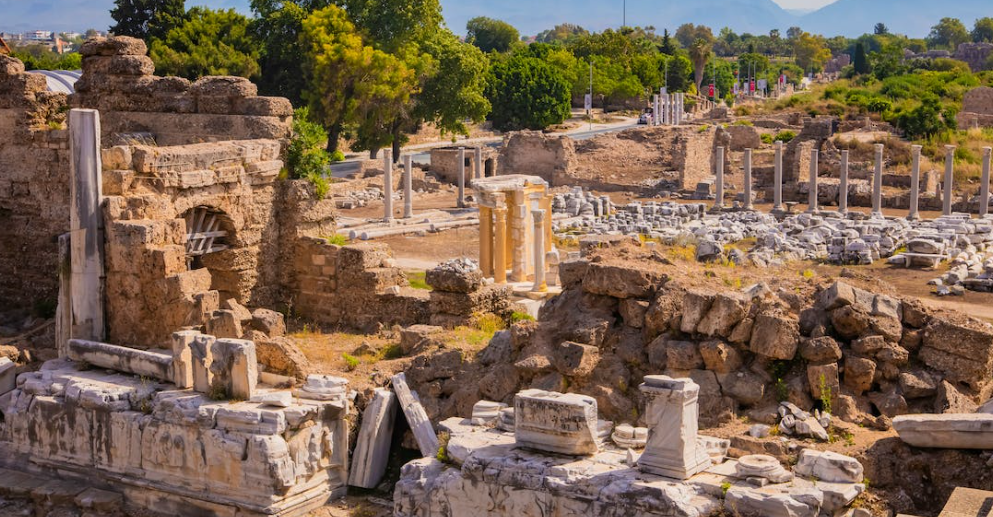Agora: Ancient Greece, The Marketplace, and the Foundations of an Enduring Human Fear!
“You need to get out more!” If you’re desperate, lonely, depressed, anxious, or otherwise down in the dumps, people will generally give you this universal advice. It’s solid and wholesome advice. But it can also seem dismissive. Why does the person who doesn’t want to “get out more” not want to “get out more”? Are they lazy…scared…hopeless? All that is worth knowing. Often what the person fears the most is not “out there” itself, but the judgment that shows up “out there.” The one place that undoubtedly best encapsulates this fear the most is the marketplace…or, in its original usage, the “agora.”
The word “agora” should sound familiar. It is after all where we derive the term “agoraphobia” from. Before we review that phenomenon in more depth, let us review the origins of the “agora” itself.
Ancient Greek Marketplace
The best historical examples of the “agoras” are the ones from Athens, Greece—both the Ancient Agora of Athens and the later Roman Agora. The former was located on the northwest side of the Acropolis, and both the Areopagus Hill (south) and Agoraios Kolonos (west) bounded it1. As you may have guessed, the agora was a commercial center, as well as a location for residential gatherings and political assemblies2.
The Athenian Agora was home to the Stoa Poikile (“Painted Stoa”), the covered walkway/portico from which Zeno of Citium taught his followers the practice of stoicism (hence, the name). Athenians would worship and pray at the Altar of the Twelve Gods, the Temple of Aphrodite Urania, the Altar of Zeus Agoraios, the Temples of Zeus Phraitrios and Athena Phratria, or the Temple of Ares. Workers would produce bronze and silver coinage at the marketplace’s “Mint” on the east side of the agora (where speakers would orate from the Stoa of Attalos’ “bema,” or platform)3.
During the 2nd century B.C.E., customers would purchase items from shops at the Stoa of Attalos or seek/receive justice at the Square Peristyle (originally located on the north side of the agora). On the west side of the agora, officials would update their notice boards with new legislation, public events, or military conscription. The site for this was the Monument of the Eponymous Heroes4. The agora was also home to various other temples, metroons (temples dedicated to mother goddesses), and stoas.

Eucles of Marathon built the Roman Agora approximately 100 meters east of the Athenian Agora (c. 27-17 B.C.E.)5. In 51 B.C.E., Emperor Julius Caesar had initially promised a marketplace, and Emperor Augustus provided the funds5. A large peristyle surrounds the agora’s open space, a fountain is located to the south side, a marble colonnade, shops, and the Gate of Athena Archegetis, an Ionic propylaeum (entrance), on the west side, and the Doric-style East Propylon on the east side6. The Roman Agora was also home to the Tower of Winds and various “vespasianae” (public toilets).
What would people buy and sell? During the 4th and 5th centuries B.C.E., innkeepers, and other merchants would tender fruits, clothes, pottery, perfume, incense, purple dye, wreaths, ribbons, meat, fish, vegetables, cheeses, eggs, honey, olives, and, of course, wine to the public. The Athenian Agora was a burial ground/cemetery for Greeks from the Mycenaean era (c. 1600-1100 B.C.E.)7. Excavators discovered at least 50 tholoi with multiple burials, as well as at least 80 graves containing inhumations and cremations from the Iron Age (1100-700 B.C.E.)7.
Later residences featured numerous water wells that dotted the area7. Citizens began frequenting the Athenian agora as a political and economic hotspot during the 6th and 5th centuries B.C.E. when the agora transformed into a public place7. Residents traveling from the port of Pireas and along the Panathenaic way (connected to the Diplyon Gate at the Philopappou Hill) would find a center for worship, open debate, legal proceedings, and commercial goods7. Classic figures like Socrates and Plato took to the agora’s streets and developed western philosophy, the Prytanes determined political affairs at the Tholos, and randomly selected Athenian citizens prepared laws for the assembly in the Bouleuterion7.
The Athenian Agora (and the later Roman Agora) was a spot for hustling and bustling crowds…. sunny streets…cloth-covered, shaded Stoas, oxcarts creaking along, dust clouds filling the air, and small olive trees scattered about7. Shoppers would bump into plenty of stray dogs, horses, metics, foreign travelers, citizens, and enslaved people7. The public could sell goods, share stories, and meet up with old friends…just another day in the ancient agora!
The American Farmers’ Market
As the old expression goes, some things never change…for better or for worse. Our modern, affluent world loves its GrubHub, Uber Eats, and major box stores, but our versions of the “ancient agoras” can still be quite delightful and charming. Farmers markets are of course popular in many major cities and small towns. Brooklyn…Los Angeles…Chicago…Nashville…you name it, you’ll find a market for farmers markets!
I’ll use my home city as an example. Washington, D.C. One weekend morning, I’ll stroll through a phalanx of merchant tents. People…dogs on leashes…babies in strollers…everyone, everywhere baking under the late spring or summer sun scorching down upon the nation’s capital…the 4th Street block of M Street NW, the corner of 14th and U…or DuPont Circle.
So many options! Artisanal cheese, salmon, sausages, and coffee…cucumbers, squash, green peas, tomatoes, blueberries, raspberries, cherries, strawberries, cilantro, kale, celery, cauliflower, and potatoes…paintings and jewelry and purses and satchel-bags and sunglasses and hand-woven dresses, scarves, and mittens. Disregard the advent of smartphones, modern apparel, automobiles, and Square technology for credit card purchases, and you could easily imagine yourself at the northern base of the Athenian Acropolis.

Agoraphobia
Such a pleasant, vibrant, and positive atmosphere. Right? If you’re feeling good and confident and socially motivated and enthusiastic, it certainly is! But let us return to the plight of the agoraphobe. The “agora,” be it a farmers’ market, a crowded city corner, a coffee shop, or a mall, strikes mortifying dread, fear, gloom, and doom into those who suffer from agoraphobia!
I used to think “agoraphobia” meant a fear of the outdoors. While it can mean that, “agoraphobia” is primarily a fear of crowds. Not crowds themselves, but the type of harsh judgment, hatred, mockery, and/or indifference the sufferer believes the crowds will inflict upon them. Agoraphobes fear not just outdoor spaces but also enclosed ones such as elevators8. They dread standing in line or boarding a jam-packed subway car.8 Agoraphobes frequently fear there will be no easy way to escape a crowd if their anxiety gets too much8.
“Can I get to the bathroom if there’s a big crowd or will I soil and embarrass myself in front of everyone?” “Will I have a heart attack and die?” “Can I get to the nearest hospital?” are all questions one suffering from this type of phobia may ask or think to themselves. They may avoid crowded places altogether or plead for someone to accompany them.8 A rapid heart rate, trouble breathing, chest pain or pressure, lightheadedness/dizziness, shakiness, tingling, sweating, flushing, an upset stomach, diarrhea, loss of control, and a fear of dying…many of the standard panic attack symptoms…usually kick in if the agoraphobe experiences anxiety8.

As is the case with many phobias, agoraphobia often stems from traumatic childhood experiences or serious and stressful life events (job loss, divorce, bereavement, e.g.).9 Agoraphobia can also stem from other mental illnesses, such as depression, bulimia, anorexia nervosa, alcohol/drug abuse, or contending with an abusive and controlling partner9.
What’s particularly intriguing is that the disorder/fear uses the prefix “agora.” Plenty of places across our modern world cater to immense crowds of people. Consider sports games at stadiums, Broadway shows and movie theaters, rock concerts, and music festivals. Crowded though they may be, none of these are “marketplaces,” per se. So why the specific term “agora”? Well…a marketplace is a transactional atmosphere. People bring their goods and services to bear. Criticism- whether negative or positive, subtle, or overt- abounds in any marketplace, which is the very nature of a marketplace! But what some people see as a playground others see as a battleground.
The potential for others to reject, ostracize, ridicule, or censure us, as many people know, is one of the few phobias people have that tops even our universal fear of death! “Will the crowd hate me?” “Will they abandon me?” “Will they reveal all my weaknesses, insecurities, and inadequacies?” Self-consciousness in its most quintessential form! There’s a good reason we almost all wear clothes and avoid prolonged eye contact with others; there’s a good reason why public speaking is terribly daunting to many people!
The “agora,” in all its forms, is ground zero for these types of fears. But those who suffer from it can discover an inner courage they might not have known they had. When thinkers such as Plato, Aristotle, and Socrates postulated various theories about society, the world, and the self, their methods of dialogue and self-examination proved pivotally successful. The methods they used in the crowded squares of Athens would also prove successful for soul-searching modern people seeking to discover their own equanimity and inner courage amid the crowds. The bravery to face the whole wide world and all the agoras in it!
SOURCES
[1] R. E. Wycherley, Literary and Epigraphical Testimonia (Athenian Agora) (American School of Classical Studies, 1957), p. 27.
[2] Sakoulas, Thomas. “The Agora of Athens”. ancient-greece.org. Retrieved 4 November 2017.
[3] “Agora Monument Mint – ASCSA.net”. agora.ascsa.net. Retrieved 28 November 2021.
[4] “Agora Monument Eponymous Heroes – ASCSA.net”. agora.ascsa.net. Retrieved 28 November 2021.
[5] Schmalz, Geoffrey C. R. (2009). Augustan and Julio-Claudian Athens: a new epigraphy and prosopography. Leiden: Brill.
[6] Camp, John M. (2001). The Archaeology of Athens. London: Yale University Press.
[7] History of the Athenian Agora (ancient-greece.org)
[8] Agoraphobia – Symptoms and causes – Mayo Clinic
[9] Causes – Agoraphobia – NHS (www.nhs.uk)
Discover more from DG Speaks
Subscribe to get the latest posts sent to your email.






One Comment
Comments are closed.